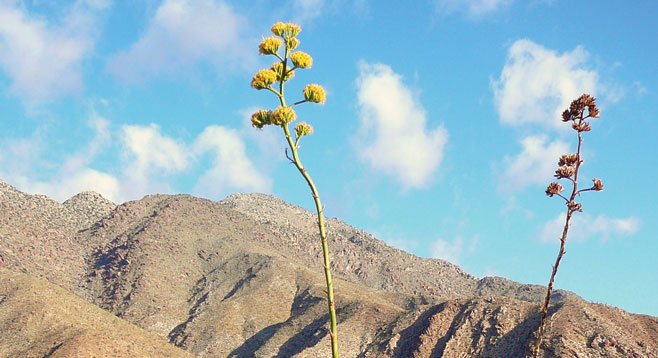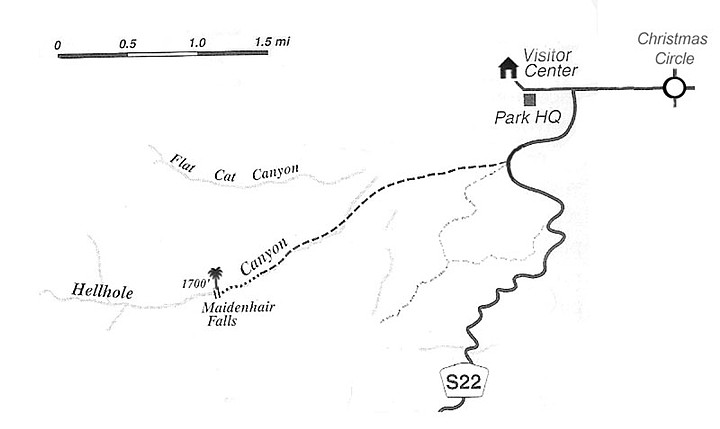 Facebook
Facebook
 X
X
 Instagram
Instagram
 TikTok
TikTok
 Youtube
Youtube

Despite the formidable name, Hellhole Canyon is one of the most delightful canyons in Anza-Borrego Desert State Park, with sycamores, cottonwoods, and palm trees fed by intermittent streams. The goal of this hike is the 18-foot waterfall cascade called Maidenhair Falls and the pool below the falls. The face of the falls and the surrounding grotto are surrounded by lacy maidenhair fern and mosses — a rare site in a desert canyon. Orchids have also been sighted in the area.
Begin the hike from the parking area and follow the wide, well-worn path up the alluvial fan to the narrowing mouth of the canyon where the ribboned pattern of Julian schist becomes visible on the canyon walls. A cautionary sign reminds you that you are in mountain-lion country. Vegetation typical of alluvial vans, such as creosote, burroweed, chuparosa, cheesebush, buckhorn cholla, agave, and desert lavender give way to desert willow, brittlebush, jojoba, ocotillo, teddy-bear cholla, and white sage. As the canyon narrows and steepens, the first palm trees and sycamores become visible. Shiny-leafed yerba santa is near the first palm grove where flowing water is found. Cottonwoods also lap up the flowing water and provide some shade. Deep-green-leafed chaparral sugar bush becomes visible at the higher elevations.

Use caution ascending the narrow canyon that is filled with boulders and thorny mesquite and acacia, or wait-a-minute bush. It is best to hike in long sleeves to avoid scratches. The thorny underbrush led to the name Hellhole Canyon. In earlier days, cattle would roam down into the canyon from Culp Valley. Cattleman Wid Helm reportedly said that the canyon was “one hell of a hole to get cattle out of.”
Keep generally to the south side of the creek. Note the occasional mortero grinding holes in the granitic rocks left by the Indians who frequented this canyon. They harvested the canyon’s mesquite beans and palm fruit and depended on the water source.
About 200 yards above a large palm grove of about 20 trees, begin listening for falling water. The falls are hidden in shrubbery behind a large boulder and are easy to miss. The shady grotto makes a great lunch stop before retracing your steps back to the parking area.
Distance from downtown San Diego: 90 miles. Allow 2 hours (Anza-Borrego Desert State Park). Drive to Ramona and follow Hwy 78 east 15 miles to Santa Ysabel. Turn north (left) on Hwy 79 and after 11 miles turn southeast (right) on S-2. At the turn-off for S-22 (Montezuma Valley Road) turn east (left) and follow S-22 to the bottom of the grade, watching for the turn to the west (left) into the Hellhole Canyon parking area. Restrooms.
Hiking length: 6 miles round trip. Allow at least 4–5 hours.
Difficulty: Moderately strenuous with some boulder scrambling required. The elevation gain is 1000 feet to the waterfall. Wear sturdy boots and carry water.


Despite the formidable name, Hellhole Canyon is one of the most delightful canyons in Anza-Borrego Desert State Park, with sycamores, cottonwoods, and palm trees fed by intermittent streams. The goal of this hike is the 18-foot waterfall cascade called Maidenhair Falls and the pool below the falls. The face of the falls and the surrounding grotto are surrounded by lacy maidenhair fern and mosses — a rare site in a desert canyon. Orchids have also been sighted in the area.
Begin the hike from the parking area and follow the wide, well-worn path up the alluvial fan to the narrowing mouth of the canyon where the ribboned pattern of Julian schist becomes visible on the canyon walls. A cautionary sign reminds you that you are in mountain-lion country. Vegetation typical of alluvial vans, such as creosote, burroweed, chuparosa, cheesebush, buckhorn cholla, agave, and desert lavender give way to desert willow, brittlebush, jojoba, ocotillo, teddy-bear cholla, and white sage. As the canyon narrows and steepens, the first palm trees and sycamores become visible. Shiny-leafed yerba santa is near the first palm grove where flowing water is found. Cottonwoods also lap up the flowing water and provide some shade. Deep-green-leafed chaparral sugar bush becomes visible at the higher elevations.

Use caution ascending the narrow canyon that is filled with boulders and thorny mesquite and acacia, or wait-a-minute bush. It is best to hike in long sleeves to avoid scratches. The thorny underbrush led to the name Hellhole Canyon. In earlier days, cattle would roam down into the canyon from Culp Valley. Cattleman Wid Helm reportedly said that the canyon was “one hell of a hole to get cattle out of.”
Keep generally to the south side of the creek. Note the occasional mortero grinding holes in the granitic rocks left by the Indians who frequented this canyon. They harvested the canyon’s mesquite beans and palm fruit and depended on the water source.
About 200 yards above a large palm grove of about 20 trees, begin listening for falling water. The falls are hidden in shrubbery behind a large boulder and are easy to miss. The shady grotto makes a great lunch stop before retracing your steps back to the parking area.
Distance from downtown San Diego: 90 miles. Allow 2 hours (Anza-Borrego Desert State Park). Drive to Ramona and follow Hwy 78 east 15 miles to Santa Ysabel. Turn north (left) on Hwy 79 and after 11 miles turn southeast (right) on S-2. At the turn-off for S-22 (Montezuma Valley Road) turn east (left) and follow S-22 to the bottom of the grade, watching for the turn to the west (left) into the Hellhole Canyon parking area. Restrooms.
Hiking length: 6 miles round trip. Allow at least 4–5 hours.
Difficulty: Moderately strenuous with some boulder scrambling required. The elevation gain is 1000 feet to the waterfall. Wear sturdy boots and carry water.